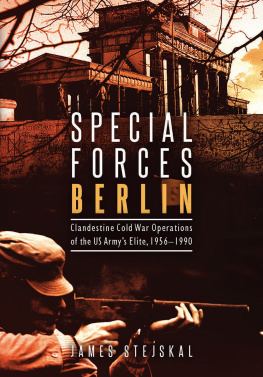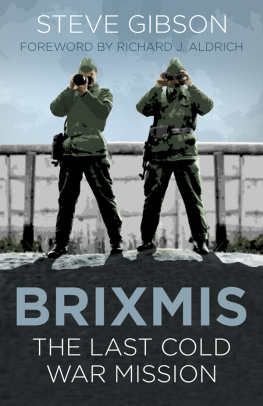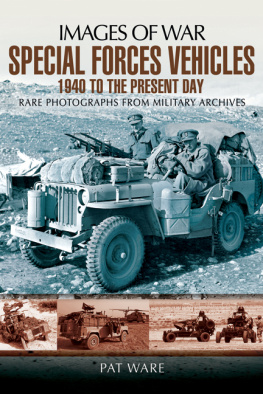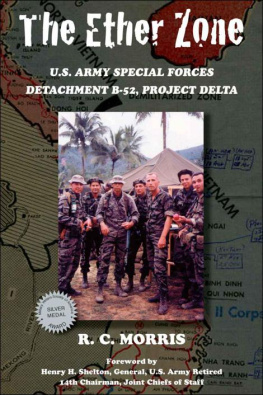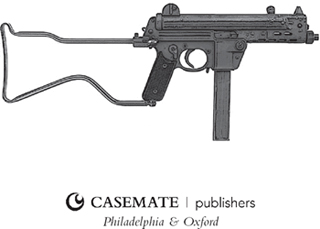
SPECIAL FORCES BERLIN
SPECIAL FORCES BERLIN
Clandestine Cold War Operations of the US Armys Elite, 19561990
JAMES STEJSKAL
Published in the United States of America and Great Britain in 2017 by
CASEMATE PUBLISHERS
1950 Lawrence Road, Havertown, PA 19083, USA
and
The Old Music Hall, 106108 Cowley Road, Oxford OX4 1JE, UK
Copyright 2017 James Stejskal
All statements of fact, opinion or analysis are those of the author and do not reflect the official position or views of the United States Government. The material has been reviewed by the DOD, CIA and NSA solely to prevent disclosure of classified material and its release does not imply endorsement or factual accuracy of the material.
Hardcover Edition: ISBN 978-1-61200-444-0
Digital Edition: ISBN 978-1-61200-445-7
Mobi Edition: ISBN 978-1-61200-445-7
A CIP record for this book is available from the British Library.
All rights reserved. No part of this book may be reproduced or transmitted in any form or by any means, electronic or mechanical including photocopying, recording or by any information storage and retrieval system, without permission from the publisher in writing.
For a complete list of Casemate titles, please contact:
CASEMATE PUBLISHERS (US)
Telephone (610) 853-9131
Fax (610) 853-9146
Email:
www.casematepublishers.com
CASEMATE PUBLISHERS (UK)
Telephone (01865) 241249
Fax (01865) 794449
Email:
www.casematepublishers.co.uk
FOREWORD
With this excellent telling, James Stejskal has made an important contribution on several levels to our acknowledged history of US Army Special Forces and the development of todays American special operations capability.
The book recognizes a unit, the members of which were among the most impactful of giants on whose shoulders the current special operators stand, whether in the SF Groups or in the most clandestine of our special operations SMU outfits. My generation of SF soldiers learned how to be effective in a denied area, using a complex mix of tradecraft, ingenuity, common sense, light infantry, and guerrilla warfare techniques in sabotage and subversion, with a nuance and deftness required to survive to accomplish our unconventional (UW) mission. Their exploits, known to few by design, but long rumored can now be shared with the public and SOF professionals. It is fitting too that the unit be recognized and her members honored before time finishes with these great men.
It is also important that as the unconventional pendulum swings back into vogue, that current practitioners and policy makers recognize that as the saying goes, there is little new, more often it is simply the history we dont know. Pushed by longstanding enemies of the West, who have again embraced this ancient form of lethal competition as a natural consequence of our dominance of the conventional battlefield, the US needs to seriously study not only the phenomenon of Russias use of little green men and Irans manipulation of its surrogates abroad, but also the importance of the West having its own UW capability. James book reminds us that our own UW roots are deep and that US unconventional warfare units have played important roles since World War II.
More importantly, in the era of counterterrorism, Det A teaches us that successfully concluding such campaigns will require investing our best and brightest in deep understanding of foreign cultures and causes, and an ability to work among the peoples who are warring against us. It is hard stuff but not impossible. Further, it is a military task but one that will have close association with intelligence agencies and their paramilitary sections, a relationship that can be strained and counterproductive unless the parties develop a confidence and familiarity with each other. James highlights how in the very close quarters of Berlin such cooperation could be very productive for the country.
Lastly, James rounds out the picture of US military involvement during one of the most unique periods and in the most unique of operating environments, Cold War Berlin. I can think of no other place that served as such a beacon for historys good guys. For in that fight, that is who we, the West, were. While much is known of the US Armys occupation forces and subsequent storied units, the last being the Berlin Brigade, until now little has been said about SFs role. But it is important to be reminded that even the good guys have had and need their own version of little green men.
Enjoy this eminently readable and enjoyable history. Get to know the men who over the years moved in the ranks of one of the finest special operations units ever created. With all the hype generated in recent years by far less discreet and less capable special units, its good to read about a unit who remained in the shadows until history and discretion allowed a public accounting. I was honored to have known many who were in her ranks and humbled by their quiet confidence in the most difficult and underappreciated service to our great country.
LTG Charles T. Cleveland, US Army Retired
Former Commanding General
US Army Special Operations Command
ACKNOWLEDGMENTS
This book is dedicated to that One Percent that serve our country and especially the 800+ men who served with Special Forces Berlin from 1956 to 1990. The writing and publication of this work would not have been possible without the encouragement and assistance of many people. The expertise and comments of my friends and comrades, the former members of Detachment A and Physical Security Support Element Berlin, assisted me greatly in the re-telling of this story. I especially wish to thank CSM Jeffrey Raker, US Army (Ret), for his friendship and mentorship when we all needed itit made much difference to all of us and kept several out of Fort Leavenworth. His reading of the manuscript ensured it was balanced and, for the most part, fair. Sadly, on November 10, 2016, CSM Raker entered Valhallahe was a true warrior leader. The incisive comments of Lieutenant General Charles Cleveland were highly appreciatedhis experience and insights made for some interesting conversation and assisted immensely in my descriptions of command issues and the militarys upper echelons. I would also like to sincerely thank Colonel Bill Iron Man Davis for his help and strength.
Additionally, the staffs of the National Archives and Records Administration at College Park, the US Army Center for Military History at Fort McNair, and the Special Forces Museum at Fort Bragg were extremely helpful and forthcoming.
The staff of Casemate Publishing in Oxford, Clare Litt, Ruth Sheppard, and Hannah McAdams as well as Tara Lichterman in the USA, did exceptional work to keep the book on track. I would especially like to thank my patient wife, Ambassador Wanda Nesbitt, whose encouragement, along with her incisive reading and commentary, helped immensely in the writing of the work. Finally, I have made all possible effort to locate and acknowledge copyright holders and apologize for any inadvertent infringement. The responsibility for any errors or omissions in this work lies with me alone.
James Stejskal
Alexandria
PREFACE
This book relays the history of a little-known and highly classified US Army Special Forces Detachment that was stationed in Berlin, Germany from 1956 to 1990.
It came into existence in response to the threat posed by the massive armies of the Soviet Union and its Warsaw Pact allies to the nations of Western Europe. The conventional wisdom at the time was that the Soviet hordes would quickly overrun the defenses of the North Atlantic Treaty Organization. US military planners decided they needed a Hail Mary plan to slow the juggernaut they expected when and if a war began.
Next page
